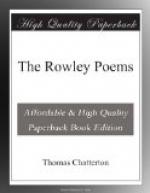The Sarasen lokes owte: he doethe feere, &c. (Eclogue the Second, 23.)
Soe wylle wee beere the Dacyanne armie
downe,
And throughe a storme of blodde wyll reache
the champyon crowne.
(AElla, 631.)
Loverdes, how doughtilie the tylterrs joyne! (Tournament, 92.).
In fine, there is no poet, one may boldly declare, whose pages are so filled with battle, murder and sudden death, as Chatterton’s are; and this is perhaps the clearest indication he gives of immaturity.
But if his ideas were sometimes crude and boyish they were not by any means always so; he has flashes of genius, sudden beauties that take away the breath. A better example than this of what is called the sublime could not be found:
See! the whyte moone sheenes onne hie;
Whyterre ys mie true loves shroude;
Whyterre yanne the mornynge skie,
Whyterre yanne the evenynge cloude.
(AElla, 872.)
and, from the Songe bie a Manne and Womanne,
I heare them from eche grene wode tree,
Chauntynge owte so blatauntlie,
Tellynge lecturnyes to mee,
Myscheefe ys whanne you are nygh.
(AElla, 107.)
Did ever shepherd’s pipe play a
prettier tune?
He has some fine martial sounds,
as for instance:
Howel
ap Jevah came from Matraval
(Battle of Hastings, I, 181.)
He rarely employs personifications, but no poet used the figure more convincingly. The third Mynstrelle’s description of Autumn is a lovely thing, and one will not easily forget his Winter’s frozen blue eyes—though unfortunately that is not in Rowley.
His art was essentially dramatic, and he has some fine dramatic moments, as for example when the Usurer soliloquizing miserably on his certain ultimate damnation suddenly cries out
O storthe unto mie mynde! I goe to helle.
(Gouler’s Requiem.)
The word ‘storthe’ is a good example of Chatterton’s use of strange words. The effect of a sudden outcry which it produces would be lost in a modernized version which rendered it ‘death’.
Mr. Watts-Dunton in his article on Chatterton in Ward’s English Poets speaks of his extraordinary metrical inventiveness and of his ultimate responsibility for such lines as these—
And Christabel saw the lady’s eye
And nothing else she saw thereby
Save the boss of the shield of Sir Leoline
tall
Which hung in a murky old niche in the
wall—
the anapaestic dance of which breaks in upon the normal iambic movement of the poem with a natural dramatic propriety. He compares too The Eve of St. Agnes with the Excelente Balade of Charitie, remarking that it was only in his latest work that Keats attained to that dramatic objectivity which was ’the very core and centre of Chatterton’s genius.’
Another writer, Mr. Thomas Seccombe, speaks of his ’genuine lyric fire, a poetic energy, and above all an intensity remote from his contemporaries and suggestive (as Cimabue in his antique and primitive manner is suggestive of Giotto and Angelico) of Shelley and Keats.’




